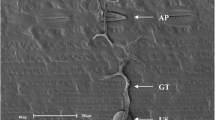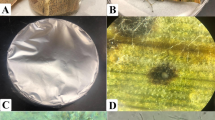Abstract
Common bunt (Tilletia tritici) infects the wheat plant during germination of the seed. For experiments with common bunt, it is conventional to examine symptoms of infection in the head of the plant. Previous research has advocated the possibility of scoring chlorosis on the leaf instead of head symp-toms in order to reduce the duration of the experiment. By comparing the two diagnosis methods in climate chambers, the current experiment demonstrated that the sensitivity and specificity of the two methods depends on the wheat cultivar used. Using leaf symptoms as a diagnosis for infection has considerable disadvantages when used for screening for resistance in breeding programs, but have advantages, e. g., when investigating effects of seed treatments.
Zusammenfassung
Steinbrand infiziert den Weizen während der Keimung und Auflaufphase. Bei Steinbrandversuchen ist es üblich, die Symptome der Infektion in den Ähren zu untersuchen. In früheren Arbeiten wurde empfohlen, Chlorosen auf dem Blatt zu bonitieren, um die Dauer des Versuches zu reduzieren. Die hier vorgelegten Ergebnisse von vergleichenden Klimakammerversuchen zeigen, dass Empfindlichkeit und Spezifität der zwei Verfahren von der verwendeten Weizensorte abhängen. Die Infektionsdiagnose anhand der Blattsymptome ist bei Verwendung in der Resistenzzüchtung mit Nachteilen verbunden. Sie hat aber Vorteile bei z. B. Untersuchungen über die Effekte von Bekämpfungsverfahren.
Similar content being viewed by others
Literature
Anonymous: Guidelines for the efficacy evaluation of plant protection products. Vol 2, Fungicides & Bactericides. — European and Mediterranean Plant Protection Organization. 1997.
Becker, J.: Untersuchungen zur Bekämpfung des Weizensteinbrandes (Tilletia tritici (Bjerk.) Wint.) mit nährstoffreichen organischen Substanzen und Mikroorganismen. Diss. Univ. Bonn, 1992.
Borgen, A.: Perennial survival of common bunt (Tilletia tritici) in soil under modern farming practice. — Z. PflKrankh. PflSchutz. 170, 182–188. 2000a.
Borgen, A.: Hvedens stinkbrand — en udfordring for principperne for økologisk plantebeskyttelse. — Ph. D. thesis, KVL, Denmark. ISBN 87-988060-0-;9. 136 p., 2000b.
Churchward, J. G.: A note on the occurrence of seedling lesions caused by cereal smuts. — Proc. Linn. Soc. New S. Wales 59, 197–199, 1934.
Hennekens, C. H., J. E. Buring: Epidemiology in medicine. — Mayrent S. L. (ed.): Boston, Mass. Little, Brown and Company cop., 1987.
Hoffmann, J. A.: Bunt of wheat. — Pl. Dis. 66, 979–986, 1982.
Josefsen, L., S. K. Christensen: PCR as a tool for early detection and diagnosis of common bunt in wheat, caused by Tilletia tritici. — Mycolog. Res. 106, 1287–1292, 2002.
Johnston, C. O., C. L. Lefebvre: A chlorotic mottling of wheat leaves caused by infections of bunt Tilletia laevis. — Phytopathology 29, 456–458, 1939.
Kendrick, E. L., L. H. Purdy: A seedling reaction of wheat indicative of bunt infection. — Phytopa-thology 49, 130–132, 1959.
Koch, E., H. Spiess: Characterization of leaf symptoms of common bunt (Tilletia caries) and relation-ship to ear attack in nine wheat cultivars. — J. Pl. Dis. Protect. 109, 159–165, 2002.
Kollmorgen, J. F, D. J. Ballinger: Detection and morphology of hyphae of common bunt fungi (Tilletia leavis and T. tritici) in wheat seedlings. — Transact. British Mycol. Soc. 88, 555–559, 1987.
Kristensen, L., A. Borgen: Reduction of spore spread of common bunt (Tilletia tritici) via combin-ing equipment. — Biolog. Agricult. Horticult. 19, 9–18, 2001.
Swinburne, T. R.: Infection of wheat by Tilletia caries (DC.) Tul., the causal organism of bunt. — Transact. British Mycolog. Soc. 46, 145–156, 1993.
Trione, E. J.: The physiology of germination of Tilletia teliospores. — Phytopathology 63, 643–648, 1973.
Tullgren, A.: Kulturväxterna och djurvärden. — Stockholm, 1929.
Zadoks, J. C., T. T. Chang, C. F. Konzak: Decimal code for the growth stages of cereals. — Weed Res. 14, 415–21, 1974.
Author information
Authors and Affiliations
Corresponding author
Rights and permissions
About this article
Cite this article
Borgen, A., Kristensen, L. Macroscopic leaf symptoms in wheat infected by Tilletia tritici. J Plant Dis Prot 110, 432–436 (2003). https://doi.org/10.1007/BF03356120
Received:
Accepted:
Published:
Issue Date:
DOI: https://doi.org/10.1007/BF03356120




